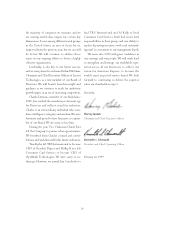American Express 1998 Annual Report Download - page 26
Download and view the complete annual report
Please find page 26 of the 1998 American Express annual report below. You can navigate through the pages in the report by either clicking on the pages listed below, or by using the keyword search tool below to find specific information within the annual report.
reported in the same segment as American Express Bank,
consistent with our management structure.
In March 1998, the American Institute of Certified
Public Accountants (AICPA) issued Statement of Position
(SOP) 98-1, “Accounting for the Costs of Computer
Software Developed or Obtained for Internal Use.” The
SOP, which the Company will adopt on January 1, 1999,
requires the capitalization of certain costs incurred to
develop or obtain software for internal use. The Company’s
policy has been to expense such costs as incurred. As a
result of adopting the new SOP, the Company expects to
capitalize approximately $250 million in 1999 that other-
wise would have been expensed as incurred. The Company
plans to increase investment spending by the amount cap-
italized, net of depreciation, and therefore, expects no
significant effect on net income.
In December 1997, the AICPA issued SOP 97-3,
“Accounting by Insurance and Other Enterprises for
Insurance-Related Assessments.” The SOP, which the
Company will adopt on January 1, 1999, provides guidance
on accounting by insurance and other enterprises for assess-
ments related to insurance activities. Adoption of this
statement will not have a material effect on the Company’s
financial position or results of operations.
In June 1998, the FASB issued SFAS No. 133,
“Accounting for Derivative Instruments and Hedging
Activities,” which is effective January 1, 2000. This Statement
establishes accounting and reporting standards for derivative
instruments, including certain derivative instruments embed-
ded in other contracts, and hedging activities. It requires that
an entity recognize all derivatives as either assets or liabili-
ties on the balance sheet and measure those instruments at
fair value. The accounting for changes in the fair value of a
derivative depends on the intended use of the derivative and
the resulting designation. The ultimate financial effect of the
new rule will be measured based on the derivatives in place
at adoption and cannot be estimated at this time. Based on
the Company’s current derivatives position, the effect on the
Company’s earnings and financial position upon adoption
would not be significant.
24
RESULTS OF OPERATIONS
STATEMENTS OF INCOME
(Amounts in millions)
Years Ended December 31, 1998 1997 1996
Net Revenues:
Discount Revenue $ 6,115 $ 5,666 $ 5,024
Net Card Fees 1,587 1,604 1,668
Travel Commissions and Fees 1,647 1,489 1,422
Other Revenues 2,534 2,211 2,175
Lending:
Finance Charge Revenue 2,007 1,848 1,575
Interest Expense 653 604 507
Net Finance Charge
Revenue 1,354 1,244 1,068
Total Net Revenues 13,237 12,214 11,357
Expenses:
Marketing and Promotion 1,130 1,027 957
Provision for Losses and Claims:
Charge Card 701 858 743
Lending 922 817 635
Other 56 57 73
Total 1,679 1,732 1,451
Charge Card Interest Expense 809 743 688
Net Discount Expense 665 597 554
Human Resources 3,544 3,076 2,907
Other Operating Expenses 3,346 3,254 3,190
Total Expenses 11,173 10,429 9,747
Pretax Income 2,064 1,785 1,610
Income Tax Provision 700 621 559
Operating Income 1,364 1,164 1,051
Restructuring Charge (net of tax) ––125
Net Income $ 1,364 $ 1,164 $ 926
Travel Related Services (TRS) reported earnings of
$1.36 billion in 1998, a 17 percent increase from $1.16 bil-
lion in 1997. 1996 earnings were $1.05 billion, excluding
a $125 million ($196 million pretax) restructuring charge.
TRS’ net revenues rose 8 percent in both 1998 and
1997 compared with the previous year. In both years,
TRS’ net revenues benefited from growth in worldwide
billed business and Cardmember loans outstanding, as well
as wider interest margins. 1998 results also reflect higher
travel commissions and fees, primarily from acquisitions
during the year. In both 1998 and 1997, growth in
billed business resulted from higher spending per Basic
Cardmember and growth in average cards outstanding.
Greater spending per Basic Cardmember resulted from
several factors, including the benefits of rewards programs
and expanded merchant coverage. In 1998, substantial
growth in cards in force outside the United States was off-
set by the cancellation of 1.6 million U.S. Government
cards late in the fourth quarter, as a result of the Company’s
decision to withdraw from the U.S. Government Card
business. The international increase includes growth in
proprietary products, as well as the addition of a substan-
tial number of new network cards over the past year. The
growth in worldwide cards in force in 1997 was primar-
ily attributable to new credit card product launches and
a broader product portfolio.
TRAVEL RELATED SERVICES
























